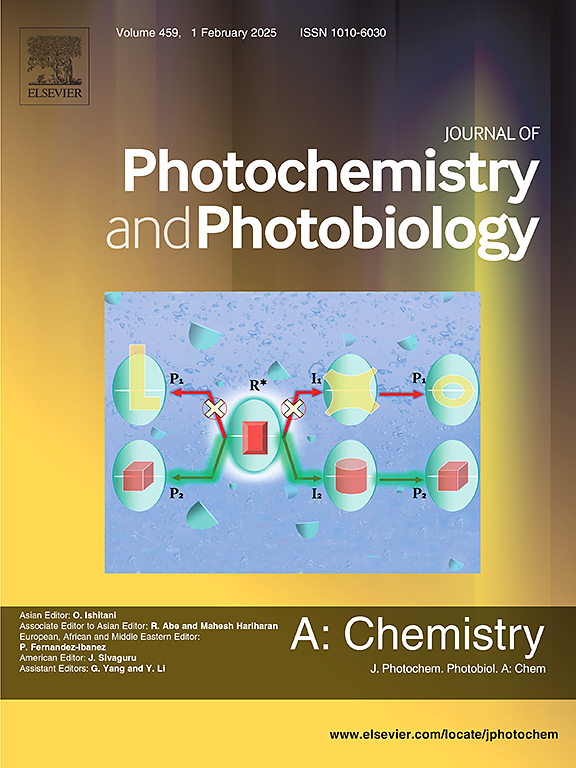Rational synthesis of Eu3+ and Yb3+ single −doped and co-doped Ba0.5Sr0.5TiO3 phosphors for dynamic anti-counterfeiting and fingerprint recognition applications
IF 4.7
3区 化学
Q2 CHEMISTRY, PHYSICAL
Journal of Photochemistry and Photobiology A-chemistry
Pub Date : 2025-06-02
DOI:10.1016/j.jphotochem.2025.116519
引用次数: 0
Abstract
The Eu3+ and Yb3+ ions single −doped and co-doped Ba0.5Sr0.5TiO3 (BST5) phosphors were prepared by a polyacrylamide gel method. The effects of rare earth ion concentration and ion type on the phase structure, microstructure, optical, color properties and photoluminescence properties of the BST5 phosphor were investigated by various characterization methods. Since the concentration of doped ions is less than 1 %, and Eu3+ and Yb3+ ions occupy the Ba/Sr site of the BST5 phosphor, the phase structure of the BST5 phosphor is not changed. Microstructure characterization confirmed that the co-doping of Eu3+ and Yb3+ with BST5 phosphor made the rhomboid particles more uniform in size. In addition to the band absorption of the BST5 phosphor, all phosphors also have two absorption peaks at 371 and 445 nm caused by Eu3+ ion ground state 7F0 to excited states 5L6 and 5D2, respectively. Simultaneously, the co-doping changes the lattice constant and crystal structure stability of BST5, resulting in a slight shift in the absorption peak. When the excitation wavelength is 395 nm, BST5:Eu and BST5: 0.25 %Eu:Yb phosphor have the strongest emission peaks at 595 and 598 nm, respectively. The photoluminescence mechanism confirmed that the existence of superexchange between Eu3+-O-Ti4+ and energy transfer between Eu3+ and Yb3+ enhanced the photoluminescence performance of the BST5:0.25 % Eu:Yb phosphor. The practical application shows that the BST5: Eu/Yb phosphor has a potential application prospect in the field of photoluminescence, dynamic anti-counterfeiting and fingerprint recognition.

合理合成Eu3+和Yb3+单掺杂和共掺杂Ba0.5Sr0.5TiO3荧光粉,用于动态防伪和指纹识别
采用聚丙烯酰胺凝胶法制备了Eu3+和Yb3+离子单掺杂和共掺杂Ba0.5Sr0.5TiO3 (BST5)荧光粉。采用多种表征方法研究了稀土离子浓度和离子类型对BST5荧光粉的相结构、微观结构、光学性能、颜色性能和光致发光性能的影响。由于掺杂离子浓度小于1%,且Eu3+和Yb3+离子占据了BST5荧光粉的Ba/Sr位,因此BST5荧光粉的相结构没有发生变化。微观结构表征证实了Eu3+和Yb3+与BST5荧光粉共掺杂使菱形颗粒尺寸更加均匀。除了BST5荧光粉的波段吸收外,所有荧光粉在371和445 nm处也有两个吸收峰,分别是由Eu3+离子基态7F0到激发态5L6和5D2引起的。同时,共掺杂改变了BST5的晶格常数和晶体结构稳定性,导致吸收峰发生轻微位移。当激发波长为395 nm时,BST5:Eu和BST5: 0.25% Eu:Yb荧光粉的发射峰分别在595 nm和598 nm处最强。光致发光机理证实了Eu3+-O-Ti4+之间的超交换以及Eu3+和Yb3+之间的能量转移增强了bst5: 0.25% Eu:Yb荧光粉的光致发光性能。实际应用表明,BST5: Eu/Yb荧光粉在光致发光、动态防伪、指纹识别等领域具有潜在的应用前景。
本文章由计算机程序翻译,如有差异,请以英文原文为准。
求助全文
约1分钟内获得全文
求助全文
来源期刊
CiteScore
7.90
自引率
7.00%
发文量
580
审稿时长
48 days
期刊介绍:
JPPA publishes the results of fundamental studies on all aspects of chemical phenomena induced by interactions between light and molecules/matter of all kinds.
All systems capable of being described at the molecular or integrated multimolecular level are appropriate for the journal. This includes all molecular chemical species as well as biomolecular, supramolecular, polymer and other macromolecular systems, as well as solid state photochemistry. In addition, the journal publishes studies of semiconductor and other photoactive organic and inorganic materials, photocatalysis (organic, inorganic, supramolecular and superconductor).
The scope includes condensed and gas phase photochemistry, as well as synchrotron radiation chemistry. A broad range of processes and techniques in photochemistry are covered such as light induced energy, electron and proton transfer; nonlinear photochemical behavior; mechanistic investigation of photochemical reactions and identification of the products of photochemical reactions; quantum yield determinations and measurements of rate constants for primary and secondary photochemical processes; steady-state and time-resolved emission, ultrafast spectroscopic methods, single molecule spectroscopy, time resolved X-ray diffraction, luminescence microscopy, and scattering spectroscopy applied to photochemistry. Papers in emerging and applied areas such as luminescent sensors, electroluminescence, solar energy conversion, atmospheric photochemistry, environmental remediation, and related photocatalytic chemistry are also welcome.

 求助内容:
求助内容: 应助结果提醒方式:
应助结果提醒方式:


